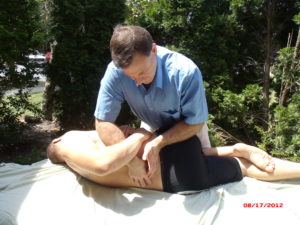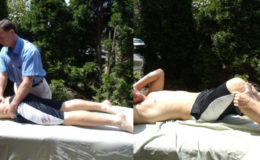A new study published in the April 2017 “Journal of the American Medical Association (JAMA)” shows that receiving spinal manipulation can decrease acute low back pain, improve functioning, and is just as effective as taking a Non Steroidal Anti-Inflammatory Drug (NSAID). The type of study performed was a Systematic Review. A Systematic Review is the highest form of a study in which all studies of a specific topic are reviewed and analyzed. The reviewer sets up specific criteria from which studies examined will either meet, or not meet. If the study meets the criteria set it is used, if not, it is excluded. This study included 26 studies of clinicians using various forms of manipulative therapy for the treatment of low back pain. The study examined manipulative techniques performed by physical therapists, chiropractors, osteopathic physicians, and medical doctors.
What is Manipulation/Mobilization ?
First, the terms manipulation and mobilization are synonymous. To manipulate or mobilize something (within the body) to is induce a skilled therapeutic movement. With respect to soft tissues, manipulation (or mobilization) can be in the form of massage, trigger point, dry needling, various forms of soft tissue release including the fascia (connective tissue), etc…, all applied to muscles and connective tissues. Organs can also become bound down causing pain, requiring release through techniques called “Visceral Manipulation”. Even nerves as they travel through the body can become bound down requiring mobilization. With respect to joints, the movements induced can be “non thrust” techniques such as gentle oscillations and manual tractioning from various positions. And, “thrust” techniques in which the movement induced is a quick therapeutic movement allowing for “pop” sound when applied. Both “Non Thrust” and “Thrust” techniques have beneficial effects; as was found in this study.
The study found that regardless of who performed the manipulative procedures, or what specific techniques were used, that the benefits were equal to that of taking a Non Steroidal Anti-inflammatory Drug (NSAID). This is exceedingly important given the epidemic of addictions to pain medications. In light of the Opioid epidemic ongoing at this time, the American College of Physicians had instituted new guidelines for “Non Pharmacologic” treatment of acute, subacute, and chronic lower back pain. This would certainly indicate the necessity of hands on, one on one manipulative care.
How does manipulative care work?
Given our current scientific understanding, here is how manipulative care works. Within our joints, muscles, and connective tissues are receptors that send information to the brain. When some of those receptors are stimulated, it decreases pain. Also, by manipulating soft tissues and joints you also increase blood flow to an injured area. This is crucial to heeling. In fact, the rate of healing is directly proportional to the amount of blood flow to that structure. The use of soft tissue manipulation can also release muscle tightness and adhesions that occur within muscles and the surrounding connective tissue (fascia) which contributes to pain. And, it that’s not enough, the mobilization/manipulation of joints helps to restore its positioning, its ability to move, and its ability to absorb forces allowing for pain free movement and return to normal functioning. Manipulation of the spine also allows for relaxation of the muscles surrounding the spine.
The Need For Therapeutic Exercises
What’s also needed for a more complete reduction/resolution of pain, and some of you make hate reading this, is the application of gentle therapeutic exercise. The muscle pumping action will increase blood flow allowing for faster healing (as mentioned above). It will also help to realign repaired tissues to prevent adhesions and contractions. It will help the muscle to relearn a more correct firing and movement pattern. And, it will strengthen and stabilize what was corrected with the hands. The one thing that we all cannot get away from is that we use our muscles in everything that we do. However, the application of manual/manipulative therapy makes any therapeutic exercise activity more effective and less difficult. Its allows for a faster rate of healing and more complete resolution than exercise alone, or just lying on a machine.
If you are having low back pain, or pain in any other area of the body, my advice in this blog is to find a provider that will provide both manual/manipulative care along with specific, custom tailored therapeutic exercise activities. I would advise one to find a licensed professional that provides individualized, one on one care and not a provider that treats multiple patients at one time. Even if you have to use an out of network provider or pay cash for the service. Given that nowadays most people are paying deductibles, co-insurance, and copays for in-network providers, you are paying for the service anyway. So, why not choose a provider that provide personalized, one on one care and resolve you pain faster and more completely with less visits?
About the author, Dr. Mitchell Kosheff is a clinical doctor of physical therapy and a certified specialist in manual therapy. He is also cross licensed as a massage and bodywork therapist. He is owner of Alternative Manual Physical Therapy And Massage, LLC: Providing Solutions to those with Problems causing pain, stiffness, and loss of functioning without the use of medications, injections, or surgery. We keep people mobile, active, and engaged in the activities that they love through the use of personalized, one on one, hands on care, and patient education. Servicing the Jackson, NJ and surrounding areas. Website: www.drmitchpt.com Visit the website and then call for a FREE telephone consultation. The telephone number is on the website.
Ref:
1) Paige, NM; et. al., Association of Spinal Manipulative Therapy With Clinical Benefit And Harm For Acute Low Back Pain: Systematic Review And Meta-Analysis. JAMA: 2017, April 11; 37(14): 1451-1460
2) Nonpharmacologic Therapies for Low Back Pain: A Systematic Review for The American College of Physicians Clinical Practice. Annals of Internal Medicine: 4 April 2017



